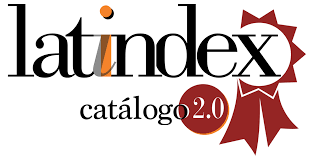Investigación en comunicación. Metodologías, temáticas y fuentes/ Communication research. Methodologies, themes and sources
DOI:
https://doi.org/10.5783/revrrpp.v9i18.622Palabras clave:
Revistas científicas, Divulgación, Investigación, Comunicación, Referencias, MetodologíasResumen
Las revistas científicas son actualmente el principal instrumento de divulgación con el que cuenta la comunidad científica para transmitir sus investigaciones, siendo el ámbito de la comunicación uno de los que ha experimentado un mayor crecimiento en este tipo de publicaciones. Dada esta proliferación de investigaciones en este campo, son necesarios los estudios bibliométricos como el presente, que persigue como objetivos primordiales: conocer el estado de la cuestión de la investigación en el campo de la comunicación en la actualidad a través de un análisis de contenido, cuyas variables han permitido saber el género de los autores, conocer su procedencia, estudiar la tipología de investigación, las metodologías de los textos y analizar el tipo de fuentes que utilizan en sus investigaciones. Se han analizado, como representativos, los 148 artículos que componen el primer número publicado en los años 2016 y 2017 por cada una de las diez primeras revistas de comunicación indexadas en el Journal Citation Reports(JCR), de Web of Science.
Los resultados nos han mostrado que la posición de las mujeres respecto a los hombres en la autoría ha ido mejorando progresivamente. En cuanto a las referencias, se concluye que las autocitas son bastante frecuentes y van en aumento, ya que en 2016 el 84,61% de autores y autoras se autocitan, incrementándose la cifra en 2017 hasta un 88,57%. Además, la tendencia es el aumento de referencias a artículos de revistas en detrimento de los libros, dándose también la circunstancia de que transcurra menos tiempo desde que se publica un artículo hasta que se cita, que en el caso de los libros.
Palabras clave: Revistas científicas, Divulgación, Investigación, Comunicación, Referencias, Metodologías
Abstract
Scientific journals are currently the main instrument of dissemination with which the scientific community transmits their researches, being the field of communication one of those that has experienced the greatest growth in this type of publications. Given the proliferation of researches in this field, bibliometric studies such us this one are necessary, which pursues as primary objectives: the currently knowledge of scientific activity in the field of communication and the analysis of the sources referenced in scientific articles; this will allow to discover the main theories and authors that support these articles in the main journals in the field of communication research.
Content analysis has been used as a method, whose variables have allowed us to know the gender of the authors, their origin, the topic of the articles, the type of research, the methodologies of the texts and analyse the type of sources they use in their investigations. The 148 articles that make up the first issues published in 2016 and 2017, belonging to the first ten communication journals indexed in theJournal of Citation Reports(JCR), of Web of Science, have been analysed as representative.
The results have shown us that the number of articles published in this type of journals is increasing, since they are higher in 2017 than in 2016. The number of signatories of each article is also increasing, being in 2016 the 2, 24 the average number and 3.31 in 2017. Analysing the gender variable, there is a notable difference between the two years; the number of men doubles the number of women in 2016, becoming stabilized in 2017. Regarding to the origin of the researchers, in both years studied, it is the USA the country with a higher percentage, followed by Netherlands and United Kingdom. Focusing the attention on Spanish researchers, they are only present in 2016 in the Communication Research magazine and in 2017 in the Journal of Communication. In both cases there is an article in each magazine where two Spanish people participate, doing it in collaboration with other researchers with different nationalities in 2017. In 2016, the most popular topic in scientific publications is health with 25.64%, secondly, it is advertising and communication campaigns with 12.81%, and the third one is social interaction with 11.50%. In 2017, the predominant theme is digital media (Internet, new technologies and social networks) with 30%, followed by social interaction with 21.44% and health communication with 12.58%.
Regarding the references, it is concluded that citing themselves are quite frequent and they are increasing, since in 2016, 84.61% of authors cite themselves, increasing the figure in 2017 to 88.57%. It is found that this practice is increasing in order to give greater visibility to the work of the researchers themselves. Also, the tendency is the increase of references to articles of magazines to the detriment of the books, and also less time elapses since an article is published until it is cited, than in the case of books.
Keywords: Scientific journals, Dissemination, Research, Communication, References, Methodologies
Descargas
Citas
ÁLVAREZ, A. y CASTILLO, A. (2015). Autores en revistas latinoamericanas de mayor impacto en comunicación. Opción, 31(3), 70-90. Recuperado de http://hdl.handle.net/11336/42347
CASTILLO, A. (2011). El rol de las publicaciones científicas en Comunicación en el EEES: indexación e impacto. Revista Internacional de Relaciones Públicas, 1 (1), 135-154. doi: http://dx.doi.org/10.5783/RIRP-1-2011-07-135-154
CASTILLO, A. y CARRETÓN, M.C. (2010). Investigación en Comunicación. Estudio bibliométrico de las Revistas de Comunicación en España. Comunicación y Sociedad, XXIII (2), 289-327. Recuperado de http://hdl.handle.net/10045/22678
CASTILLO, A., PEÑA, V. y MAÑAS, S. (2014). Revistas de comunicación en España. Una aproximación histórica. Historia y Comunicación social, 19, 621-630. Recuperado de https://revistas.ucm.es/index.php/
CASTILLO, A., RUBIO, A. y ALMANSA, A. (2012). La investigación en comunicación. Análisis bibliométrico de las revistas de mayor impacto del ISI. Revista Latina de Comunicación Social, (67), 248- 270. doi: 10.4185/RLCS-067-955-248-270
COMPTE-PUJOL, M., MATILLA, K. y HERNÁNDEZ, S. (2018). Estrategia y Relaciones Públicas: un estudio bibliométrico comparativo. Revista Latina de Comunicación Social, 73, 748-764. doi: 10.4185/RLCS-2018-1280
COPE, B. y KALANTZIS, M. (2009). Signs of Epistemic Disruption: Transformations in the Knowledge System of the Academic Journal. First Monday, 14 (4). Recuperado de http://www.ojphi.org/ojs/index.php/fm/article/view/2309/2163HICS/article/viewFile/45053/42424
GÓMEZ, I. y BORDONS, M. (1996). Limitaciones en el uso de los indicadores bibliométricos para la evaluación científica. Política Científica, (46), 21-26. Recuperado de http://digital.csic.es/bitstream/10261/9813/1/20090122134420909.pdf
OSCA-LLUCH, J. (2012). Aspectos regionales de las revistas españolas de ciencias sociales y humanidades: calidad y visibilidad internacional. Biblio 3 W. Revista Bibiográfica de Geografía y Ciencias Sociales, XVII (998). Recuperado de http://www.ub.edu/geocrit/b3w-998.htm
REPISO, R. (2015). Cómo identificar una revista de calidad. Cardiocore, 50 (2), 46-48. doi: http://dx.doi.org/10.1016/j.carcor.2014.12.002
Descargas
Archivos adicionales
Publicado
Cómo citar
Número
Sección
Licencia
Los autores que publican en esta revista están de acuerdo con los siguientes términos:- Los autores conservan los derechos de autor y garantizan a la revista el derecho de ser la primera publicación del trabajo al igual que licenciado bajo una Creative Commons Attribution License que permite a otros compartir el trabajo con un reconocimiento de la autoría del trabajo y la publicación inicial en esta revista.
- Los autores pueden establecer por separado acuerdos adicionales para la distribución no exclusiva de la versión de la obra publicada en la revista (por ejemplo, situarlo en un repositorio institucional o publicarlo en un libro), con un reconocimiento de su publicación inicial en esta revista.
- Se permite y se anima a los autores a difundir sus trabajos electrónicamente (por ejemplo, en repositorios institucionales o en su propio sitio web) antes y durante el proceso de envío, ya que puede dar lugar a intercambios productivos, así como a una citación más temprana y mayor de los trabajos publicados (Véase The Effect of Open Access) (en inglés).




